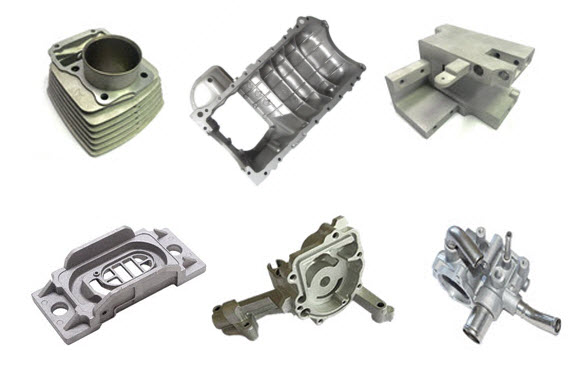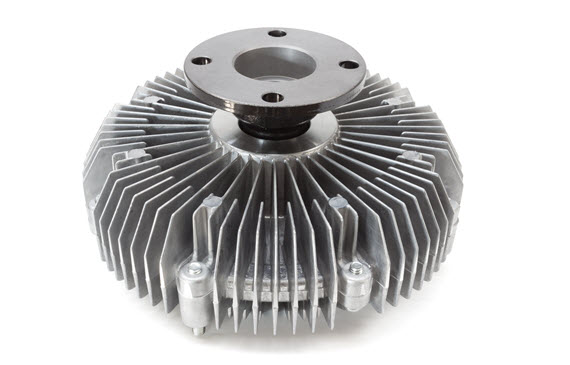Wisconsin Aluminum Foundry and Aluminum Castings: partners in production excellence
Discovering the Versatile Utilizes and Applications of Aluminum Castings in Modern Industries
Light weight aluminum castings have come to be integral to various modern markets because of their unique properties. They offer substantial advantages in weight decrease, thermal conductivity, and rust resistance. From auto innovations to applications in customer goods and construction, their versatility is impressive. The true level of their impact extends beyond instant benefits, hinting at broader implications for sustainability and efficiency. What exists in advance for aluminum spreadings in an ever-evolving commercial landscape?
Automotive Sector Innovations
The automotive industry has actually significantly accepted aluminum castings to improve lorry performance and efficiency. By making use of light weight aluminum, suppliers can create lighter components, which add to improved gas economic climate and lowered exhausts. Trick applications consist of engine blocks, transmission instances, and architectural components, where the product's strength-to-weight ratio provides sturdiness without adding excess weight.
Aluminum castings additionally offer remarkable thermal conductivity, which assists in far better heat dissipation, therefore enhancing engine performance. Innovations in casting modern technologies, such as die casting and sand casting, allow the manufacturing of complex geometries, enabling for innovative styles that enhance room and functionality.
The recyclability of light weight aluminum lines up with sustainability objectives in the automotive market, advertising eco pleasant techniques. As the industry proceeds to innovate, using light weight aluminum castings is most likely to expand, driving further advancements in automobile layout and effectiveness.
Aerospace Applications and Improvements
While the aerospace industry proceeds to prioritize weight reduction and fuel effectiveness, light weight aluminum castings have actually become a vital material option for different applications. Their light-weight nature, paired with high strength-to-weight ratios, enables for considerable renovations in airplane efficiency and performance. Aluminum castings are commonly utilized in structural parts, such as body structures and wing components, where minimizing weight is important.
Current advancements in aluminum spreading technologies, consisting of improved alloy formulations and accuracy spreading techniques, have further improved the product's efficiency abilities. These innovations enable the manufacturing of intricate geometries and detailed designs while preserving architectural integrity. Furthermore, light weight aluminum's exceptional rust resistance assurances longevity and integrity in extreme aerospace environments.
As the aerospace field increasingly accepts sustainability, aluminum spreadings supply a recyclable option that straightens with environment-friendly methods, making them a pivotal aspect in the advancement of next-generation aircraft.
Durable Goods and Everyday Products
As consumers increasingly seek lightweight yet long lasting products for day-to-day items, light weight aluminum castings have acquired appeal in various customer products. The one-of-a-kind residential properties of aluminum, including its resistance to deterioration and exceptional thermal conductivity, make it an optimal choice for products like cooking equipment, household devices, and outdoor equipment. Aluminum cast pans and pots supply also warm distribution, improving cooking efficiency. In addition, making use of aluminum in things such as bike frames and baggage ensures a balance between toughness and mobility. Manufacturers appreciate light weight aluminum castings for their convenience, as they can be conveniently molded into complex forms while preserving architectural honesty. Additionally, the ability to reuse light weight aluminum without weakening its buildings straightens with expanding consumer choices for lasting items. On the whole, light weight aluminum spreadings are integral to the production of resilient, useful, and visually pleasing durable goods, meeting the demands of modern way of lives.
Building and Architectural Uses
Aluminum castings have actually come to be a crucial part in building and building layout, especially because of their toughness and light-weight nature. These buildings make light weight aluminum a perfect selection for various applications, including structural components, exteriors, and decorative features - Wisconsin Aluminum Foundry. Contractors and designers progressively make use of aluminum spreadings for home window frameworks, doors, and roof, boosting both performance and aesthetic appeals. The product's resistance to rust additionally expands its life-span, lowering maintenance expenses and making sure sturdiness in diverse environmental conditions
Aluminum can be conveniently molded right into elaborate layouts, enabling for innovative architectural expressions. Its adaptability helps with the production of customized items that fulfill details layout requirements, from elaborate railings to intricate assistances. As sustainability becomes a priority, aluminum's recyclability adds to its charm in green building and construction techniques. Generally, aluminum castings are transforming the building and construction sector by supplying light-weight, sturdy, and visually enticing solutions.
Digital and electrical Components
Light weight aluminum spreadings play a crucial role in the production of lightweight electrical units, which enhance transportability and effectiveness in different applications. On top of that, their outstanding thermal conductivity makes them optimal for warm sinks, ensuring peak performance and longevity of digital components. Aluminum's conductive homes contribute to its use in numerous electrical conductors, highlighting its significance in modern-day innovation.
Light-weight Electrical Enclosures
Lightweight electric rooms play a vital duty in safeguarding sensitive digital elements from environmental factors and physical damages. Constructed from light weight aluminum castings, these rooms are valued for their strength-to-weight proportion, making them excellent for various applications across sectors. Their lightweight nature help in lowering general system weight, which is important in mobile and mobile electronic devices. Furthermore, light weight aluminum's rust resistance improves resilience, extending the life-span of the encased parts. The ability useful source to mold and mildew light weight aluminum into complex forms permits tailored layouts, satisfying specific requirements while ensuring effective heat dissipation. In addition, these enclosures can be quickly incorporated into existing systems, supplying versatility and convenience in modern technological environments. Generally, lightweight light weight aluminum enclosures considerably add to the performance of electronic devices.
Heat Sinks and Conductors
While lots of products are made use of in electronic components, aluminum spreadings stick out for their effectiveness in heat monitoring as warmth sinks and conductors. Their exceptional thermal conductivity permits effective warm dissipation, which is essential in protecting against the overheating of electronic devices. Light weight aluminum's light-weight nature additionally improves its viability for applications where weight is a considerable variable, such as in aerospace and automotive markets. Furthermore, light weight aluminum castings can be quickly built right into complex forms, providing design versatility for maximizing thermal performance. The rust resistance of light weight aluminum likewise adds to the durability and reliability of these elements in different environments. As technology breakthroughs and devices come to be much more compact, the need for efficient heat monitoring options, like light weight aluminum castings, remains to grow.
Marine Market Use
The marine sector increasingly depends on aluminum castings for their extraordinary durability and corrosion resistance. These homes make aluminum an ideal selection for various applications, consisting of watercraft hulls, engine components, and aquatic hardware. The lightweight nature of light weight aluminum spreadings allows boosted gas effectiveness and easier maneuverability in watercraft, which is essential for both recreational and commercial vessels.

Aluminum spreadings additionally provide substantial cost benefits due to their long life-span and low maintenance needs, lowering the total functional expenses for aquatic drivers. Additionally, the convenience of aluminum enables intricate layouts that can meet details efficiency needs.
Makers in the aquatic market make use of advanced casting techniques to produce intricate shapes, making sure that elements satisfy extensive safety and performance requirements. As the need for high-performance aquatic vessels expands, aluminum castings are placed as a vital material in boosting the performance and durability of aquatic devices.
Sustainability and Recycling in Light Weight Aluminum Spreading

Aluminum Recycling Refine
Recycling aluminum plays a necessary role in minimizing environmental effect and conserving resources within the casting market. The light weight aluminum recycling process starts with the collection of scrap aluminum, which can include old parts, producing waste, and post-consumer items. This scrap is then arranged, cleaned up, and shredded right into small items to promote melting.
As soon as prepared, the aluminum scrap is thawed in a heater at reduced temperatures than key aluminum production, significantly minimizing power consumption. The liquified click here to find out more light weight aluminum is after that cast right into ingots or various other forms for reuse in various applications - Wisconsin Aluminum Foundry. This closed-loop system allows for the effective healing of aluminum, protecting its residential properties while minimizing the need for virgin materials. As a result, the reusing procedure is an important part of lasting techniques in aluminum spreading
Ecological Advantages
While aluminum spreading plays a critical role in different markets, its environmental benefits are especially impressive concerning sustainability and resource conservation. The lightweight nature of aluminum adds to energy efficiency in transportation, minimizing gas intake and exhausts. Additionally, light weight aluminum spreading facilitates the use of recycled products, greatly lowering the power needed for production compared to primary aluminum. This reusing process decreases waste and minimizes the environmental influence related to mining and refining resources. Aluminum is 100% recyclable without destruction click this link of its buildings, advertising a lasting lifecycle. By picking aluminum casting, markets can significantly reduce their carbon impact while promoting resource efficiency, making it a vital option in the pursuit of eco-friendly manufacturing methods.
Closed-Loop Solutions

Frequently Asked Inquiries
What Are the Key Perks of Aluminum Castings Over Other Products?
Aluminum castings supply lightweight residential or commercial properties, superb rust resistance, and high strength-to-weight ratios. They can be quickly formed into intricate forms, supply excellent thermal and electric conductivity, and are economical, making them more effective over numerous different products.
Just how Is the Light Weight Aluminum Casting Process Eco-friendly?
The aluminum casting process is environmentally pleasant as a result of its recyclability, reduced energy consumption, and decreased waste production. Its capability to utilize recycled products lessens the carbon footprint, advertising sustainability within manufacturing practices.
What Are Usual Challenges in Aluminum Spreading Production?
Usual obstacles in aluminum spreading production include preserving dimensional accuracy, handling thermal tightening, stopping issues like porosity and inclusions, making sure appropriate mold design, and optimizing production effectiveness while lessening material waste and environmental influence.
Just How Do Light Weight Aluminum Castings Contrast in Cost With Other Manufacturing Approaches?
Light weight aluminum spreadings commonly use affordable expenses compared to various other producing techniques, specifically for medium to high-volume manufacturing. Their lower initial tooling expenditures and reliable material use can cause positive business economics gradually.
What Future Patterns Are Expected in Light Weight Aluminum Casting Modern Technology?
Future patterns in aluminum spreading modern technology are expected to consist of innovations in automation, enhanced alloy make-ups, enhanced reusing techniques, and the combination of 3D printing, all focused on raising effectiveness, reducing prices, and reducing ecological impact.
Current developments in aluminum casting innovations, consisting of improved alloy solutions and accuracy spreading methods, have further boosted the product's performance capabilities. Light weight aluminum spreadings have ended up being an essential component in building and building style, particularly due to their toughness and lightweight nature. The aluminum reusing procedure begins with the collection of scrap light weight aluminum, which can consist of old parts, making waste, and post-consumer items. When prepared, the aluminum scrap is melted in a heater at reduced temperature levels than main aluminum manufacturing, considerably decreasing energy consumption. Furthermore, aluminum spreading helps with the usage of recycled materials, greatly decreasing the energy required for production contrasted to main light weight aluminum.